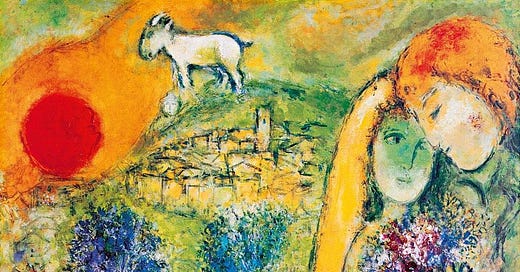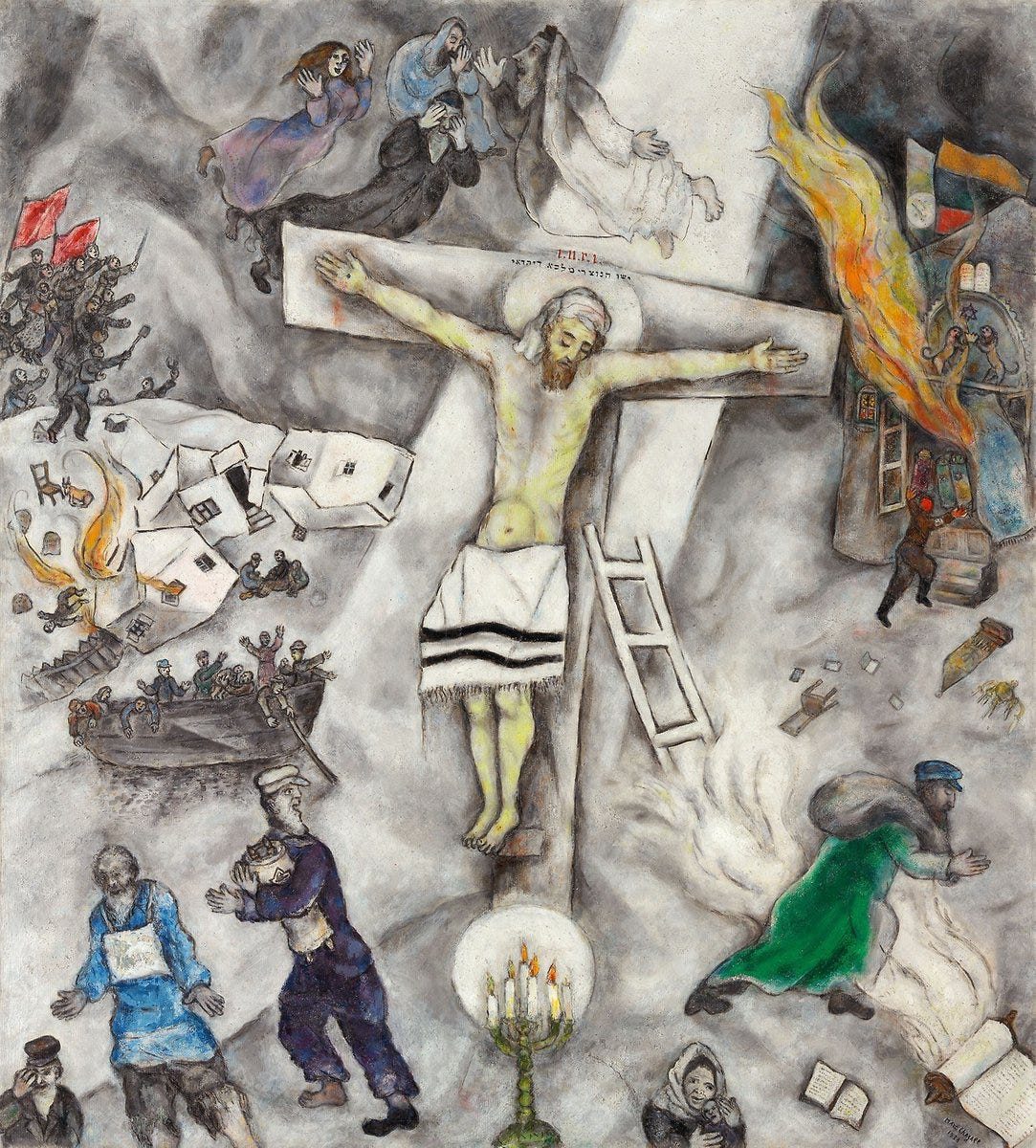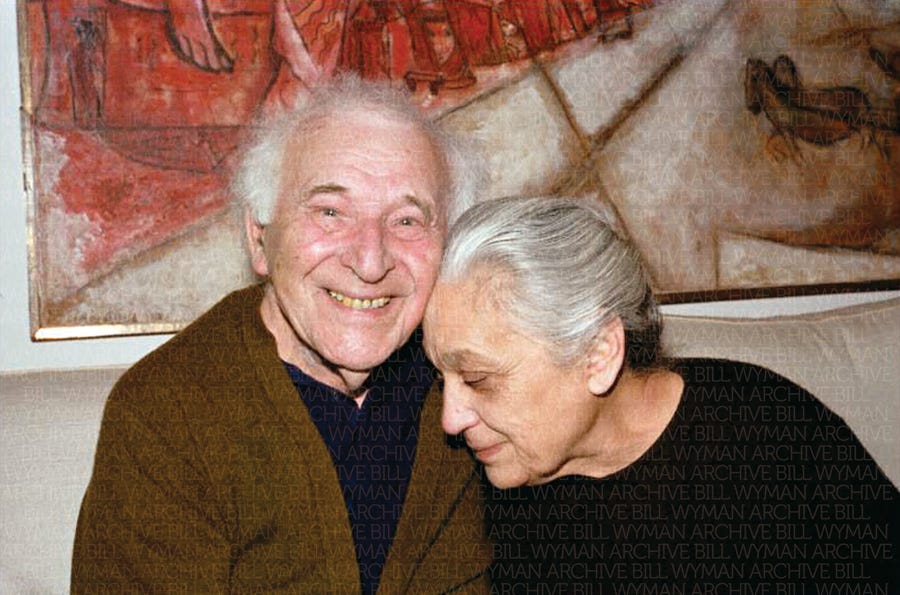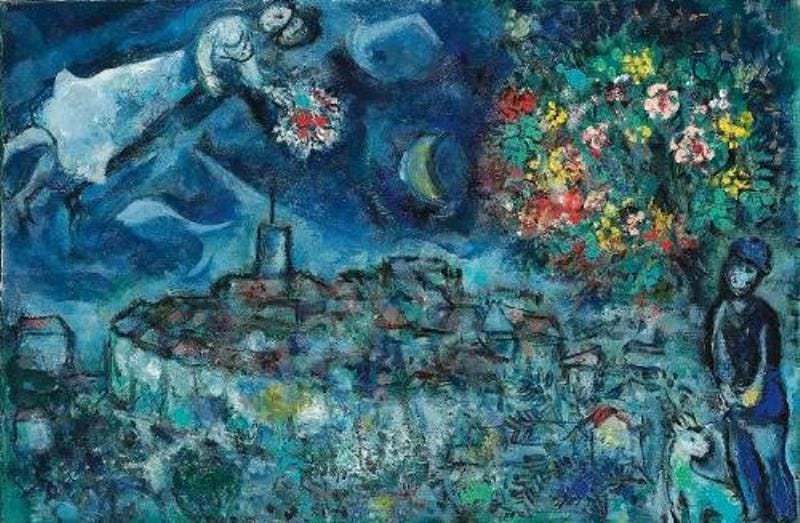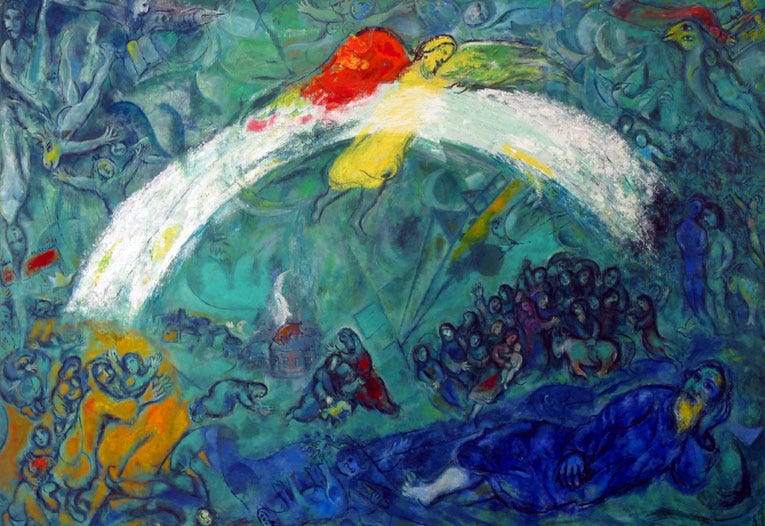If Today You Hear His Voice, Harden Not Your Hearts
Countering the Satanic Evil of Antisemitism
All artists and writers have their Muses. Chagall is one of mine. I turn to him quite often and do so because of his universal beliefs, often expressed by the inclusion of both Jewish and Christian symbolism. Chagall's art serves as a bridge between these two traditions, emphasizing the commonalities of human spirituality and the shared themes of love, suffering and hope.
His inclusive approach aimed at promoting understanding and harmony between different faiths. I sought his assistance with this particular piece because of the alarming rise of evil Antisemitism and hate throughout the world. Who knew such hatred was harbored by so many, festering beneath the surface and dormant for many years, perhaps being coerced into silence by shame?
It’s beginning to resemble kristallnacht1 out there! Herr Doktor Goebbels would be proud of this new Hitler Youth.
Antisemitism is not just a mere prejudice; it is a dark, insidious evil that poisons the very soul of humanity. It maturates in the depths of ignorance and hatred, casting a malevolent shadow over history. Unmasking the Satanic evil of Antisemitism reveals the disturbing persistence of an age-old bigotry, a poison that has led to untold suffering and the horrors of the Holocaust being played out yet again across the globe.
It is a reminder that we must confront this evil with unwavering resolve, for in doing so, we not only stand against hatred but also protect the values of tolerance, compassion and the sanctity of every human life.
Chagall's art was deeply affected by the rise of Antisemitism in his own time and the horrors of the Holocaust. His work during this period often featured somber and poignant imagery that conveyed the suffering and persecution of the Jewish people. Paintings like "The White Crucifixion" and "The Jewish Bride" are examples of his response to the plight of Jews in Europe. Chagall once remarked, "For me, Christ has always been and will always be Jewish, but it is not for the Nazis to decide who is and who is not Jewish."
A Muse ignites a writer's imagination, guides their thoughts and infuses their work with sparks of inspiration. Writers often invoke their chosen Muse, seeking divine assistance to access deeper creativity or choose the right words to convey their ideas. Muses are seen as the wellspring of creative energy, offering a connection to the divine that transcends the mundane. Chagall’s muse was his first wife, Bella, who passed in 1944.
Marc Chagall - A Life in Color
Marc Chagall, born Moishe Shagal, on July 7, 1887, in Vitebsk, Russia, was a prolific and groundbreaking artist whose work traversed various styles and mediums. He is celebrated for his distinctive use of vibrant colors, dreamlike compositions and deeply emotional themes. Chagall's art defies easy categorization, as he effortlessly blended elements of Fauvism, Cubism, Surrealism and Symbolism into a unique and captivating style.
Chagall's early life was marked by the hardships faced by many Jews in Eastern Europe during that era. Yet, his creative spirit and undeniable talent propelled him forward. He studied art in Saint Petersburg and later moved to Paris, the epicenter of the modern art world in the early 20th century. Paris exposed him to a wide array of artistic influences that would shape his life’s work.
In 1966, at the age of 79, Chagall, along with his second wife Valentina Brodsky, known as Vava, discovered the quaint village of Saint-Paul-de-Vence. It was here that they decided to set down roots, captivated by its picturesque beauty and serene ambiance. The allure of Saint-Paul-de-Vence, with its labyrinthine streets and warm Mediterranean sunlight, beckoned to Chagall's artistic sensibilities.
Chagall's move to Saint-Paul-de-Vence marked a significant chapter in his life. He continued to paint with vigor and creativity, and his works from this period are often seen as an outpouring of love for the village that became his home. His paintings during this time were filled with vibrant colors, whimsical scenes and a sense of joy.
A Love Beyond Canvases
Marc Chagall's love for Vava was a central theme in his art and life. The couple's relationship was passionate and Vava served as both his new muse and manager. Together, they shared a connection that was evident in his work. In Chagall's paintings, Vava often appeared as an ethereal figure, soaring through the skies or embracing him tenderly. Their love story was immortalized on canvas, a testament to the enduring power of their bond.
Tragically, Vava’s passing left Chagall heartbroken. In a poignant tribute to his beloved wife, he created a stained-glass window for the local church in Saint-Paul-de-Vence, depicting scenes from the Bible. This masterpiece, known as the "Chagall Window," bathes the interior of the church in a kaleidoscope of colors and serves as a symbol of Chagall's enduring love and connection to the village.
After a life filled with artistic achievements and personal milestones, Marc Chagall passed away in Saint-Paul-de-Vence in March 1985. He was laid to rest in the village cemetery, overlooking the picturesque landscape that had inspired so much of his work.
Chagall's legacy endures not only in his art but also in the heart of Saint-Paul-de-Vence. The village remains a vibrant hub of artistic activity, attracting painters, sculptors, writers and creative souls from around the world. Visitors can explore a renowned art foundation featuring works by Chagall and other notable artists, as well as the charming streets that continue to inspire artists to this day.
"The Lovers of Vence"
Among Chagall's many works is the one pictured above - "The Lovers of Vence." It stands out as a poignant representation of his affection for both his wife and the village. The painting captures a dreamlike scene where lovers float above the village rooftops, enveloped in a celestial embrace. The vibrant colors and ethereal atmosphere convey a sense of eternal love and connection, reflecting the enduring spirit of Saint-Paul-de-Vence.
In the words of Marc Chagall himself, "In our life there is a single color, as on an artist's palette, which provides the meaning of life and art. It is the color of love."
As one wanders through the charming streets of Saint-Paul-de-Vence and contemplates the works of Chagall, it becomes clear that love, art and life are intricately intertwined in this picturesque village, where hearts remain open to the beauty of creativity and the enduring power of love.
Chagall's canvases often transcended time, perhaps embedding within them, unknowingly, symbols that speak to the epochs ahead. "Noah and the Rainbow" stands as one such piece, beckoning us to preserve a soft place in our hearts for the mysterious language of symbolism, which may be viewed as divine communication.
This piece, especially in the context of Noah's narrative - a story of survival amidst devastation - echoes the resilience of the Jewish spirit in the face of hate and antisemitic adversity throughout history and into the present day.
If Today You Hear His Voice, Harden Not Your Hearts
The verse, "Do not harden your hearts as you did at Meribah, as you did that day at Massah in the wilderness," refers to an episode in the Hebrew Bible, specifically found in the book of Exodus (17:1-7) and also recounted in Numbers (20:2-13). These locations - Meribah and Massah - are places where the Israelites quarreled with Moses and questioned God's presence and provision during their journey through the wilderness after the Exodus from Egypt.
In the Exodus account, the Israelites had just come from the Red Sea and were in the Desert of Sin. They had no water and complained to Moses, questioning why he had brought them out of Egypt to die of thirst. Moses then struck a rock with his staff at God's command, and water flowed out of it. The names "Meribah" and "Massah" are derived from the Hebrew words for "quarreling" and "testing," respectively. The people had quarreled with Moses and tested God by asking, "Is the Lord among us or not?"
The Jews who left Egypt wandered in the desert for 40 years. Only their descendents, a generation that grew up during the desert wanderings, entered the Promised Land. They were led there by Joshua.
This story often serves as a warning against hardening one's heart and questioning God's providence and presence, especially when facing trials. It is used in various contexts in the Bible to remind people of the importance of trust and obedience in their relationship with God.
Know that decisions to stand with Israel and reject evil will be severely tested by events in the coming days. None of the combatants in this war is able to boast of clean hands, neither the Israelis nor the Palestinians. However, also know this - there is absolutely no moral equivalence between these two! Hamas launched its October 7th attack on Israel with the explicitly stated objective of murdering civilians and capturing hostages. War crimes!
Moreover, Hamas decapitated some of their victims. Even worse, the terrorists were instructed by their leadership to “play with the severed heads.” Hamas slaughtered pregnant women, children and babies alike, while Israel, in response to this nightmarish evil, continues to abide by international law, show heroic restraint and target only legitimate military facilities and personnel, never innocent civilians.
Hamas is designated as a terrorist organization by several countries, including the United States, Israel, the European Union and others.
Isn’t it about time to treat them as such?

